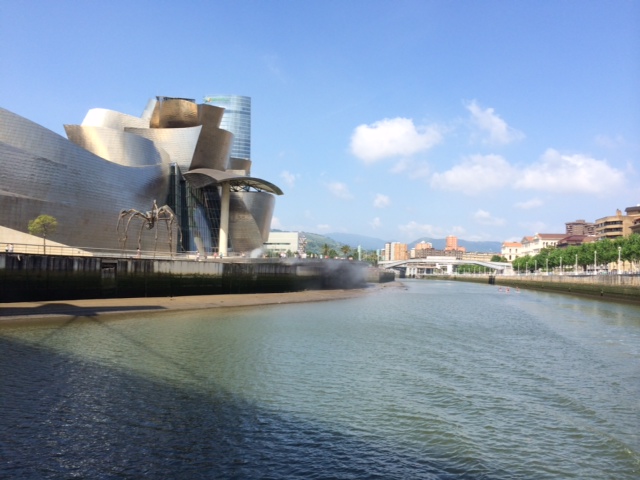
Translating people and place from Detroit to Bilbao, Spain, and back
Bilbao, Spain.
I just returned from the German Marshall Fund’s BUILD event in Bilbao, Spain. For three days, 100 Americans and Europeans on the front lines of urban innovation gathered to exchange ideas. This transatlantic engagement enables civic leaders to share best practices for cities and facilitates collaboration that improves them. As a native Michigander with limited overseas travel experience, I continue to marvel at how the language of loving cities and place translates in other countries.

Guggenheim Museum in Bilbao
First, the place. Bilbao is extraordinary. We most commonly see the picture of the Guggenheim Museum anchoring Bilbao’s revitalization. All of our events took place within walking distance of this remarkable cultural anchor. We were also within walking distance of Bilbao’s bustling historic district; a vibrant, contemporary shopping district; office buildings; government buildings; university buildings; and a robust residential community. Most of our activities took place in a landscape that, 30 years ago, was an industrial port in deep decline, contributing to a contaminated river. Today, few signs of the former industrial shipyards exist, and the fish we witnessed in the river countered the history of contamination. Quite a few of the Bilbao representatives commented that Detroit is “Bilbao 30 years ago.” I considered that a compliment, and I saw several examples that suggested Detroit is on a path that was taken by Bilbao – most notably the reclamation of the riverfront as a place for great public space and redevelopment.
The first evening provided a “Place” theme for my entire experience. Alfonso Vegara of Fundación Metrópoli, an international center of excellence dedicated to research, design and innovation, reminded all participants that in the new world economy many of the elements of a city transcend place. You can move people, ideas, goods and businesses across the world with less and less effort. He said that, based on his experience , what you cannot move or duplicate is the “magnetism” of a city. There was no doubt that Bilbao is magnetic. And it gave me great pride to remind myself that Detroit is uniquely magnetic and our magnetism is building. Nearly every visitor to Detroit I encounter comments on the power of the place, and, increasingly, I meet people from all over the world who have never visited Detroit but have heard of its magnetism and wish to see it for themselves. I believe that’s a great sign for us and affirmation that we will be able to tell a revitalization story like Bilbao’s.
Second, the people. Participants in the BUILD conference came from across the United States (Washington, D.C., Cleveland, New York, Los Angeles, Detroit, Flint, Miami, Atlanta) and across the European continent (Spain, Italy, the Netherlands, England, Poland, France, Germany). While the program included some wonderful plenaries on the story of Bilbao’s urban transformation, leading equitable and sustainable urban transformation, and innovation, the individual conversations with such a wide range of participants provided the greatest value for me. The experience, as intended, reminded me of my experience in 2011 as a German Marshall Fund Marshall Memorial Fellow. The fund thrives on bringing together smart, committed people and challenging them to expand each other’s point of view. Indeed, BUILD demonstrated to me that there is a growing cadre of leaders with experience developing and driving urban solutions. This network includes many of my colleagues in Detroit (and yes, the Detroit contingent at BUILD was strong!) who also bring home success stories gleaned by colleagues in other cities. Our successes in Detroit in turn will inform and spur the creation of city success in other places. I’m sure of it.
My favorite quote of the event came from Angela Glover Blackwell of PolicyLink, an organization committed to advancing economic and social equity. She seamlessly integrated remarks on the importance of equity and the strong link between equity and future leaders. She challenged us to identify who is essential for our communities in the future and to ensure they are equipped to participate and to lead. But it was her remark on the role of a leader that stuck most with me. “Good leaders run to the end of the road, come back, and then walk as many people as possible along with them.” (My apologies if the language is inexact.)
I think each of us at the event felt challenged to identify our future leaders and participate in equipping them with the skills needed to advance our cities’ futures. Bilbao had a compelling story about the power of its leadership to revitalize the city and the need for continued leadership to sustain and advance its future. As we at Knight Foundation continue to equip our communities to succeed, we must be ever mindful of the importance of community leadership and recognize the power of dialogue, exchange and collaboration across multiple places.
Katy Locker is the Detroit program director for Knight Foundation.
Recent Content
-
Communitiesarticle ·
-
Communitiesarticle ·
-
Communitiesarticle ·


